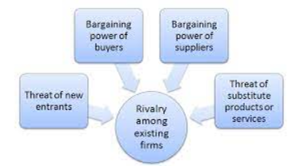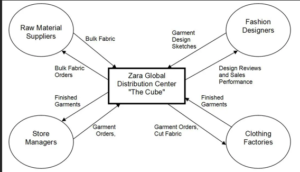Assignment Sample on Global Strategy And Sustainability
Introduction
In task 1, the external and internal environment analysis will be highlighted along with the evaluation of the sources of competitive advantages and in task 2, the clear motives of Zara’s expansion will be described with recommendations for three entry strategies.
Task 1- Internal and External environment
Porter’s five forces
Threat of substitutes
Low threat of substitutes as most of the companies in this apparel industry sell the same collection with the difference in price and colour and the customers prefer Zara UK due to its high product quality with effective customer service.
Bargaining power of buyers
The bargaining power of buyers is moderate, Zara has indirect bargaining power of buyers due to continuous changes in the fashion trends in the UK market.
Bargaining power of suppliers
The bargaining power of suppliers is low in the case of the UK Zara due to the presence of in-house production, therefore, the dependency on the suppliers is low to collect the fabrics and other raw materials.
The threat of new entrants
The low threat of new entrants due to the high brand recognition of Zara creates difficulties for new entrants to establish its market as the alternative to Zara UK. Zara’s affordable price range with unique design and low production costs help Zara to survive against the new entrants in the market (Duoyan, 2021).
Industry rivalry
High industry rivalry because of GAP, Forever 21, H&M and Mango which creates obstacles for Zara to sustain in the UK market although Zara’s customer loyalty and brand offer Zara to compete with others.

Figure 1: Porter’s five forces
(Source: Duoyan, 2021)
VRIO analysis
| Competencies | Valuable | Rare | Imitability | Organised | Competitive advantages |
| Flexible supply chain network | Yes | Yes | Yes | Yes | Sustainable competitive advantages |
| Talent management | Yes | Yes | No | Yes | Strong competitive advantage |
| Customer community development | Yes | Yes | No | Yes | Strong competitive advantage |
Table 1: VRIO analysis
(Source: Self-created)
Three critical factors from the analysis
- High industry rivalry has to be termed as the first critical factor which needs to be addressed by the company so that the company follows a customer-centric approach to compete with rivals (Zaki and Neely, 2019).
- Flexible supply chain network is considered the second critical factor which guides Zara to follow the integrated supply chain strategies to manage operational activities with the flexibility (Aftab et al., 2018).
- Customer community development, is the third factor to create relationships with customers to boost the productivity and performance of Zara.
Sources of competitive advantages and the way to maintain this
Innovative technology such as Radio Frequency identification technology (RFID) is the source of competitive advantages to improve the stock management that has been maintained through recruiting digital experts (Inditex.com, 2023). The affordable pricing strategy that Zara follows is another source of competitive advantages to increase its sales and this has been maintained through a cost leadership strategy.
Task 2- Discussion about the strategy in global environment
Entering way into foreign markets through an internationalization strategy model
In the context of the internationalization strategy model, Zara UK has to focus on global and international strategies to enter the foreign market. In the case of international strategy, Zara UK is not concerned about the costs which signifies Zara entering into a foreign market through product diversification and differentiation. In order to enter the foreign market, Zara adopts the global strategy to understand the market analysis and as per that, Zara occupies its position in that particular foreign market.
Motives of Zara’s expansion through Yip’s model
Zara’s motive for international expansion has been described through four drivers of Yip’s model which include cost, market, government and competition, Zara’s motive is to acquire global customers through international expansion. This motive is supported by the market drivers of Yip’s model and the impact of this motive on the adaptation of the Artificial Intelligence chatbot system. The second motive of Zara is to boost sales and revenue through international expansion of the business and this is influenced by the favourable logistics system of Zara as a part of the cost driver. This motive has an impact on Zara’s supply chain strategy of using an automated distribution centre named “The Cube” which is linked with store managers, fashion designers, clothing factories and raw material suppliers (Mhugos, 2023).

Figure 2: The Cube model
(Source: Mhugos, 2023)
The third motive of Zara is to distribute sustainable products and services to international customers to maintain environmental sustainability, therefore, Zara follows trade policies to other countries to distribute the products. Maintaining the trade policies to establish good relationships with neighbouring countries is the impact of Zara’s third motive influenced by the government driver of Yip’s model. Moreover, competitor drivers enhance the opportunities for Zara to increase its global networks to fulfil its motive of recognition as one of the leading apparel companies in the world. In order to fulfil this motive, Zara has focused on the enhancement of the online and offline stores to broaden the global network as a part of the impact of the motive.
Three global entry strategies to compete in the global environment
- Zara should adopt export market entry strategies by directly selling the products to other countries as it is termed as low risk with a low-cost strategy due to already existing high brand reputation.
- Partnership strategy that Zara should follow, for instance, Zara may do their partnership with an e-commerce platform of that particular country to distribute their products to the customers.
- Acquisition is another market entry strategy that Zara should consider to expand the business globally, for example, if Zara has to concentrate on entering the USA market, then Zara may acquire companies such as American Giant and Todd Shelton.
Conclusion
From the above discussion, Zara as a high brand manages the environment analysis to expand the business through the drivers mentioned in Yip’s model and market entry strategies such as exploring, acquisition and partnership.
References
Aftab, M.A., Yuanjian, Q., Kabir, N. and Barua, Z., 2018. Super responsive supply chain: The case of Spanish fast fashion retailer Inditex-Zara. International Journal of Business and Management, 13(5), pp.212-227.
Duoyan, H., 2021, April. Research on ZARA strategy from the perspective of SWOT analysis method. In 2021 6th international conference on social sciences and economic development (ICSSED 2021) (pp. 201-205). Atlantis Press.
Inditex.com, 2023. Annual report 2015 (no date) Inditex. Available at: https://static.inditex.com/annual_report_2015/en/our-priorities/innovation-in-customer-services.php#:~:text=Radiofrequency%20identification%20technology%20(RFID)%2C,and%20developed%20during%20this%20period (Accessed: February 20, 2023).
Mhugos, 2023. Zara Clothing Company Supply Chain, SCM Globe. Available at: https://www.scmglobe.com/zara-clothing-company-supply-chain/ (Accessed: February 21, 2023).
Zaki, M. and Neely, A., 2019. Customer experience analytics: dynamic customer-centric model. Handbook of Service Science, Volume II, pp.207-233.
Know more about UniqueSubmission’s other writing services:

